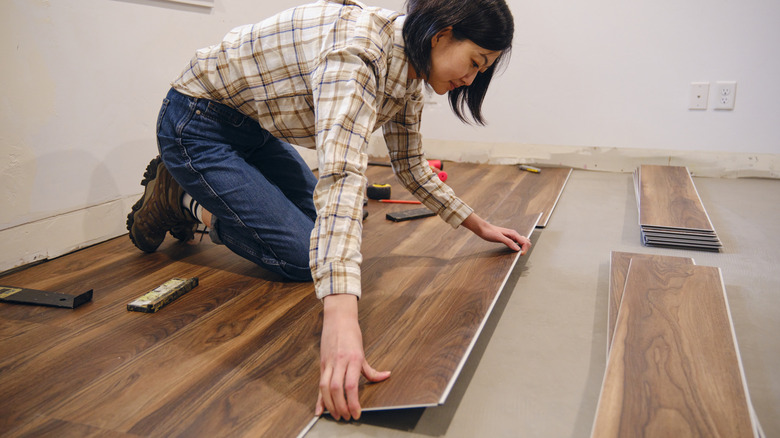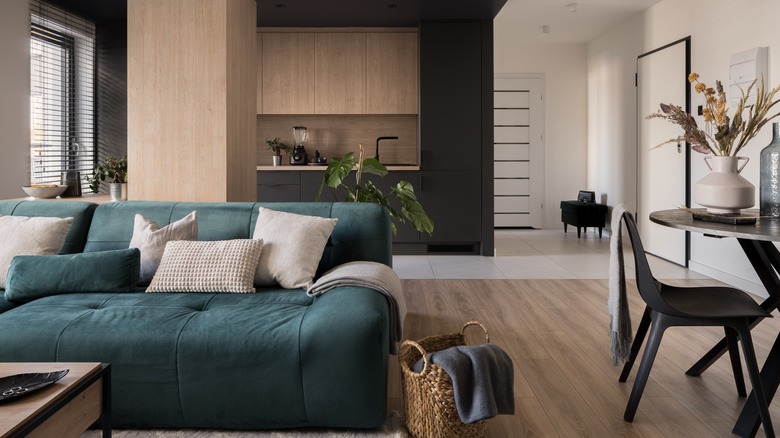The Flooring Rule Of 3: What It Is And Why You Shouldn't Break It
Learning how to decorate your interior with a mixture of styles isn't easy — after all, it's a subject people go to college to study. But there's a trick all interior designers learn: the rule of three. This rule applies to many aspects of art, design, and architecture; in the world of flooring, it means only using a maximum of three flooring finishes across your entire property — say, flagstones in the kitchen, hardwood throughout the living spaces, and teeny hexagonal tiles in the bathrooms. Deviate from this rule, and you risk offending your décor-savvy friends at best and, at worst, ruining your carefully curated layouts with visual clutter.
The rule of three serves as an organizational tool across many disciplines, from science, music, religion, and even fairy tales to the subject of this article, design. The concept dates back at least to Ancient Rome, where people espoused the Latin phrase ictum omne trium perfectum ('everything that comes in threes is perfect') in daily life. In an era where, per Dezeen, a post-industrial, individualistic approach to design is set to take over our homes, adhering to the rule of three in everything from fireplace mantle décor to flooring materials helps us coordinate our varied interests. In essence, this rule is used by interior designers to avoid clutter. A single room contains no more than three points of interest. Your coffee table has three vases of varying styles and heights. And your home boasts a maximum of three flooring finishes.
Go stand in the corner
The rule of three is undeniably one of the core interior design rules designers want you to know because it makes design choices easier, including which flooring materials you invest in. It dictates that while you shouldn't use more than three types of floors in your home, you can still make the most of the hues and textures each choice provides. One method is to use one material for communal living and transitional spaces, another for bathrooms (something water-resistant, of course), and a third for private spaces like bedrooms and studies. Try eco-friendly cork tiles in the living room, durable laminate in the hallway, and plush carpeting in the master bedroom. Another option is to create a flow from hard and soft or natural to synthetic — for example, hardwood and tile or luxury vinyl plank and wool carpet tiles. Use this trio of flooring materials to define the different functions of your home.
Unsure how to tell if your flooring — or, in fact, any group of elements in your home — is breaking the rule? Pick a room and stand in one corner, looking out over the rest of the room and not facing the wall. Can you spy more than three flooring options from this vantage point? Then that's one (or, perish the thought, more) too many. If you're undertaking a redecoration or fitting out a new build, place flooring swatches around your home to determine which materials look best together.
When three's a crowd
There's a notable exception to the rule of three. When dealing with a large, open-plan layout, some designers advise sticking to just one or a maximum of two flooring materials. "Integrating different floors in such places can be a complex puzzle that needs to be handled with care lest the aesthetic value of the house is compromised," Uganda-based interior designer Mariah Kiwagama tells New Vision. Getting your flooring just right is essential because floors are considered — along with walls, structural elements (think arched doorways and windows), and large surfaces like countertops — one of the foundational frameworks of interior décor. In other words, they set the tone for every design element you add after their installation.
Another trio-based rule that can help you with flooring material decisions is the 60-30-10 rule — this time regarding hue. The rule goes like this: 60% of space should be one color, 30% of space in another color, and 10% of the space devoted to a statement hue. Practically, this could look like gray-stained hardwood floors throughout most of the house, soft mint carpet in the bedrooms, and dramatic black tiles in the bathrooms. Continue this color palette through the property to create a cohesive design.


